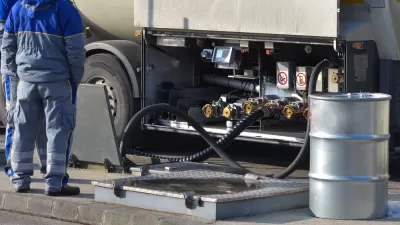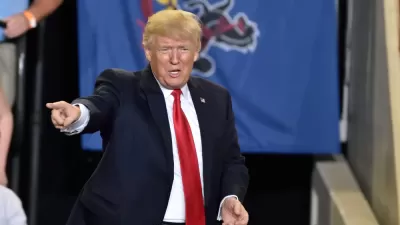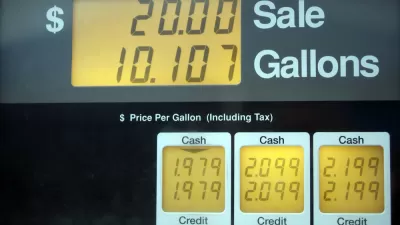Partnering with the private sector carries risks. Witness the mess that followed the selection of a private firm to build an interstate in Indiana in 2014 that Vice President Mike Pence should have prevented in his prior position as governor.

At a House Ways and Means Committee on Sept. 19, President Trump announced he would no longer rely on the private sector to finance 80 percent of his much-touted but little-seen $1 trillion infrastructure package, according to a Washington Post report (posted here Monday).
During the meeting, Trump "complained that certain partnerships between the private sector and federal government simply don’t work," reported Tory Newmyer and Damian Paletta on Sept. 26.
The president, participants in that meeting said, pointed to his vice president’s home state of Indiana to demonstrate that a public-private partnership on a federal level would not succeed.
It turns out that Vice President Mike Pence, in his prior role as governor of Indiana, left behind a financial and infrastructure mess for his successor, Gov. Eric J. Holcomb (R), to clean-up. Mark Alesia and Kaitlin L Lange, investigative and statehouse reporters for The Indianapolis Star, respectively, reported last June what went wrong with the 21-mile section of State Road 37, also known as I-69 Section 5.
At first, it sounded like a good idea: Indiana would use a public-private partnership [P3] to extend I-69 from Bloomington to Martinsville, relying on private sector ingenuity to bring it in on time and under budget.
An IndyStar investigation reveals that much of the trouble can be traced to the state’s inability to heed several warning signs about the project’s most prominent player, Isolux Corsán. The European company had more than an 80 percent stake in I-69 Development Partners, the company building the road.
There were lots of red flags that the Indiana Finance Authority should have spotted in 2014, including the substantially lower bid offered by Isolux Corsán than its competitors. The company filed for bankruptcy in July.
Even a supporter of public-private partnerships, Robert Poole of the libertarian Reason Foundation, had a harsh assessment: "This is one of the worst failures that I've seen in the state-level P3s."
Said Poole, "Given what turned out to be the financial condition of Isolux, I suspect that the Indiana Finance Authority didn’t do the due diligence they should have with that."
Financial analysts from Fitch estimate it will cost the Indiana Department of Transportation an additional $162 million to complete the roadway that was supposed to be completed almost a year ago. The new completion date is projected to be in August.
Alesia and Lange point out that it's not just money that the state has lost due to the failure of the P3. Crashes on State Road 37, the future I-69, have increased dramatically since construction began.
Haunting Pence?
State Rep. Matt Pierce, D-Bloomington, a frequent critic of I-69, blamed Pence's campaigns for governor and vice president for the state not terminating its contract sooner.
"Clearly the project started to go south under his administration," Pierce said. "They weren't interested in admitting there were any problems."
A prescient section of the June article asks, "To P3 or not to P3?", noting Pence's new position and Trump's $1 trillion infrastructure plan. Surprisingly, it would appear that Pence has not learned the needed lessons:
At a June White House event, Pence made remarkably similar claims about "leveraging private sector expertise" that he asserted on Feb. 19, 2014 when launching the venture with Isolux, observed Alesia and Lange.
For a recent examination of the track record of public-private partnerships, see the June 6 New York Times "DealB%k" article, "Public-Private Projects Where the Public Pays and Pays."
Hat tip to AASHTO Daily Transportation Update.
FULL STORY: Mike Pence's infrastructure mess: What went wrong with I-69?

Maui's Vacation Rental Debate Turns Ugly
Verbal attacks, misinformation campaigns and fistfights plague a high-stakes debate to convert thousands of vacation rentals into long-term housing.

Planetizen Federal Action Tracker
A weekly monitor of how Trump’s orders and actions are impacting planners and planning in America.

In Urban Planning, AI Prompting Could be the New Design Thinking
Creativity has long been key to great urban design. What if we see AI as our new creative partner?

King County Supportive Housing Program Offers Hope for Unhoused Residents
The county is taking a ‘Housing First’ approach that prioritizes getting people into housing, then offering wraparound supportive services.

Researchers Use AI to Get Clearer Picture of US Housing
Analysts are using artificial intelligence to supercharge their research by allowing them to comb through data faster. Though these AI tools can be error prone, they save time and housing researchers are optimistic about the future.

Making Shared Micromobility More Inclusive
Cities and shared mobility system operators can do more to include people with disabilities in planning and operations, per a new report.
Urban Design for Planners 1: Software Tools
This six-course series explores essential urban design concepts using open source software and equips planners with the tools they need to participate fully in the urban design process.
Planning for Universal Design
Learn the tools for implementing Universal Design in planning regulations.
planning NEXT
Appalachian Highlands Housing Partners
Mpact (founded as Rail~Volution)
City of Camden Redevelopment Agency
City of Astoria
City of Portland
City of Laramie





























